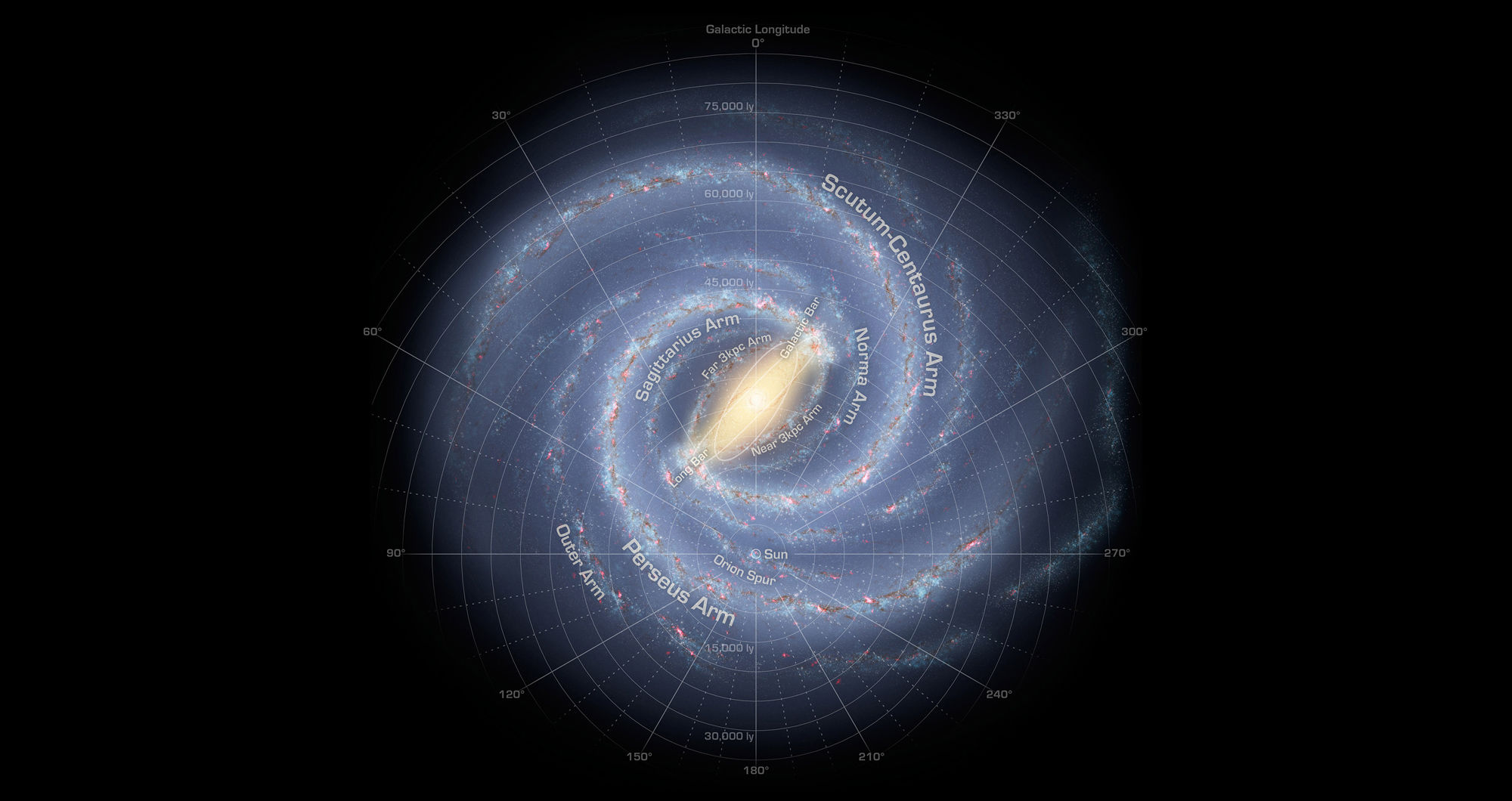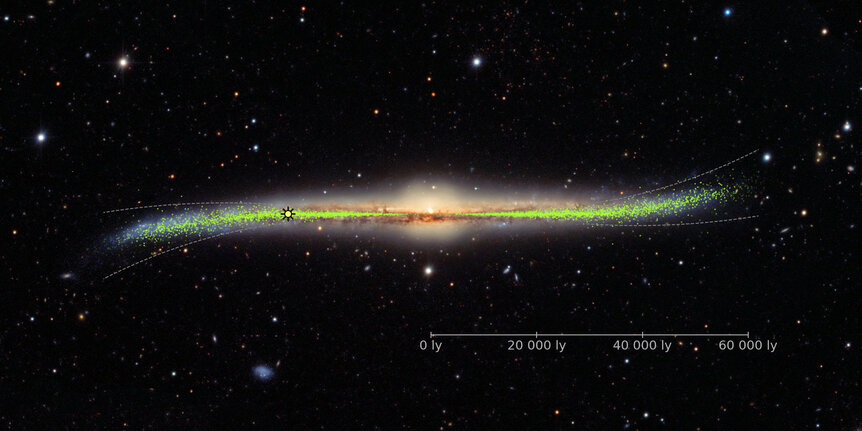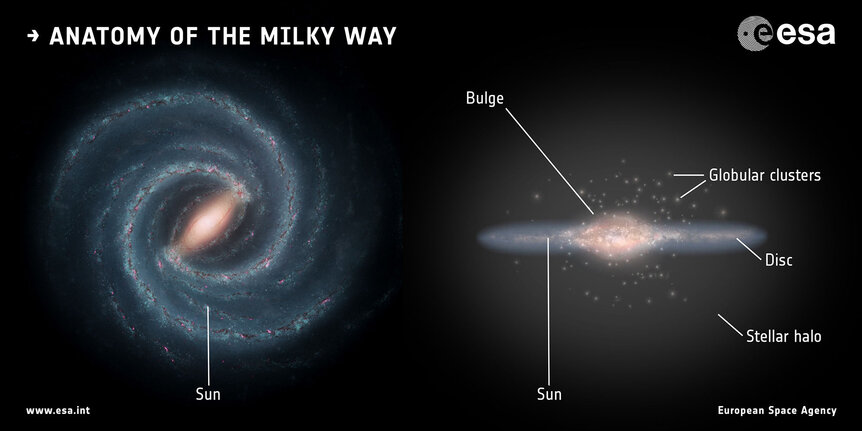Create a free profile to get unlimited access to exclusive videos, sweepstakes, and more!
How big is the Milky Way?

We live inside the Milky Way galaxy, and that's a problem.
For scientists, that is, who want to understand how big our galaxy is. That's hard to answer! Because we're inside it, for example, a lot of it is blocked from view by opaque clouds of dust. Also, it can be difficult to get a handle on the extent and shape of an object you're inside of. If you're in a room inside a house, how can you tell how big the house is?
Happily, nature provides clues. We see a fuzzy band of light across the sky, and call it the Milky Way — it's actually the combined light of billions of distant stars. It's a thick line, and that tells us that a lot of the galaxy is flat: We're inside a thick disk of stars, so we see it projected as a stream of light across the sky.
We can also see a bulge of stars in the middle, which is real. Spiral arms in the disk are more difficult to detect, but radio observations show them clearly, and allow us to map the shape and structure of the galaxy clear to the other side. By looking at stars that change brightness in a predictable way we can measure the shape and extent of the disk, finding it's warped (like the brim of a fedora), and a whopping 120,000 light years across — 120 quadrillion kilometers!
We also know that galaxies like our own are surrounded by a huge halo of stars as well as dark matter. That latter is composed of we-know-not-what, probably an exotic form of subatomic particles, which exerts influence on the galaxy via gravity. By mass it far outstrips what we call "normal" matter (though, if you think about it, if there's more dark matter out there then that should be what we call normal), probably by a factor of five or more.
But how big is this halo? It’s by far the largest structure in our galaxy, and arguably defines how big the Milky Way truly is, but it's exceedingly dim or invisible to our eyes, so getting its size is hard.
A team of astronomers recently tackled this issue. They used computer models of how galaxies form and evolve to see if the halo of a galaxy like the Milky Way has a natural edge to it, something where you can plant a sign and say "Here is where the galaxy ends." It's not that simple — haloes tend to fade away gradually instead of coming to a hard stop — but using both these models and observations of smaller galaxies around us, they find the halo of the Milky Way extends to 950,000 light years from the center, meaning our galaxy is twice that across: 1.9 million light years.
A note of caution, however; the uncertainty on this is about ±200,000 light years. It's not precise. But then, as I said above, they're not really measuring an edge.
Also the way this was done was interesting. Back in the early days of the Universe, galaxies formed from clouds of gas and dark matter. Mostly this stuff was all spread out, but there were local places that had higher density, so material would (literally) gravitate toward there. Once a core of material formed, stuff from farther out would fall in, and then stuff farther out than that, and so on. It's an inside-out process.
The halo would form from material pretty far out. It would fall toward the nascent galaxy, and a lot of it would swing back out again. This forms two kinda sorta edges to the halo. One is called the "splashback" edge, where stuff would fall in from the halo and then back out again; where it slowed to a stop defines that region. Matter piles up there because it's moving slowly, and so just outside of that you get a big dropoff in density.
Another edge is closer in to the center, and is called the "2nd caustic." This is where material has fallen around the galaxy a couple of times and has settled down a bit (what astronomer call "virialized" material). The scientists in this new work used that second one to figure out the size of the Milky Way, because the outer one tends to overlap with haloes from other galaxies (like Andromeda, which is 2.5 million light years away) and also because they found that this distance works both when modeling dark matter and stars.
They also looked at the behavior of dwarf galaxies in our Local Group of galaxies, and found that ones closer to the Milky Way than this 2nd caustic tend to move through space at a different velocity than ones farther out. They comment this may be coincidence, but it could also be a physical relationship they have with the Milky Way gravitationally. If so, it's more evidence this makes a good choice for the limit.
So there you go. We live on a planet orbiting a star about 40% of the way from the center to the edge of the disk in a spiral galaxy with a much larger halo that spans nearly two million light years across. Not the biggest galaxy we know, but not one to sneeze at, either.




























